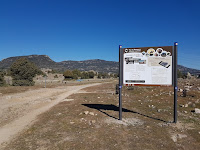Distrito Castellana
norte Madrid
September 12, 2020
Far West territory, four routes through the Far West without leaving Madrid
The Far West Territory guide includes four routes designed by the Community of Madrid as a tourist attraction and that want to publicize those scenarios that were filled with Indians and cowboys, cancan dancers and gunmen who resolved their game disputes with bullets.
The Northwest Route is the most important, since the main Madrid Westerns were filmed in La Pedriza, Colmenar Viejo and Hoyo de Manzanares.
La Pedriza was chosen very early as a location due to its resemblance to some American landscapes. What is believed to have been the first Madrid western, “Oro vil”, by Eduardo García Maroto, was filmed here in 1941, a totally Spanish production. If it was really a western it is something difficult to verify, since no copy is conserved and there are not many data that have come down to us about this film. Be that as it may, the film was not very successful. 25 years later, Clint Eastwood and Eli Wallach would star in a scene from “The Good, the Bad Ugly and the Ugly” among their characteristic rocky areas, which today belong to the Cuenca Alta del Manzanares National Park.
Colmenar Viejo holds several records: in this town what is considered the first replica of a town in the American West in Europe was built and it is the Madrid municipality where the most films of this genre have been shot. In the natural space of the dehesa de Navalvillar, four kilometers from the urban center, up to five active sets coexisted simultaneously.
Recently, in 2016, it was the location of the last film of the genre, Parada en el infierno , in which the director Víctor Matellano rescues the old western myths.
Hoyo de Manzanares also played a very relevant role, as the western town of Golden City was built there in 1962, probably the first stable town in Europe, which today can be explored using augmented reality through the ViveHoyo app . In 1964, Sergio Leone filmed the movie “A Fistful of Dollars” on this set. In this replica of an American town, which reproduced a main street dominated by a saloon and a cantina, more than 50 films of the genre were filmed.
Torremocha de Jarama, Talamanca de Jarama, Algete, Daganzo de Arriba, Alcalá de Henares and Nuevo Baztán are the towns that make up the Eastern Route of the Far West Territory. For several years they were transformed into ranches and Confederate forts. At that time, the Rio Grande border was located on the outskirts of Alcalá de Henares, by art and magic of the seventh art.
Aranjuez is one of the most cinematographic towns in Madrid. It is integrated into the South Route of the western scenarios, of which Colmenar de Oreja, Titulcia and Ciempozuelos are part.
In 1972, Charlton Heston filmed Ken Annakin's “La selva blanca” (White Fang), in Aranjuez; Ricardo Blasco's Zorro rode and forged his legend in Colmenar de Oreja, since “Las tres espadas del Zorro” (The 3 Swords of Zorro) (1963) and “El Zorro rode otra vez” (Behind the Mask of Zorro) (1964) were filmed in this town. And the Coyote, the anonymous hero with a mask brought to life by the Barcelona writer José Mallorquí, jumped into the cinema led by Joaquín L. Romero Marchent, near Titulcia, in Los Cortados, a breathtaking territory with impressive vertical walls.
The southwestern route of Madrid's Far West Territory leads us to Villamanta , Aldea del Fresno and Pelayos de la Presa , where the typical train scenes were shot and Mexican forts and towns were built. The Alberche River, as it passed through the municipality of Aldea del Fresno, was also transformed into the Rio Grande for one of the locations of the movie “A Fistful of Dollars”, by Sergio Leone.
La Casa de Campo, a 'western' setting
The Casa de Campo was another of the recurring locations of the Madrid westerns. There, “Torrejón City” was filmed in 1962, a comedy set in the west and starring Tony Leblanc. Two years later, the Toledo pavilion built for the Feria del Campo would be used for the mythical “A Fistful of Dollars” for its stone walls and Toledo-style patios. From there, other productions would return to this building, now remodeled and converted into a restaurant. The pine forests of Casa de Campo were not unrelated to other film genres, as well-known North American films such as “Spartacus”, by Stanley Kubrick (1960) or “Chimes at Midnight” were shot there by Orson Welles (1965).










I plan on making a Western in Madrid, Spain called, "Blood Never Argues" about a man who promises to go after a gang of outlaws before his wedding day. Should be fun. Wish me luck.
ReplyDelete